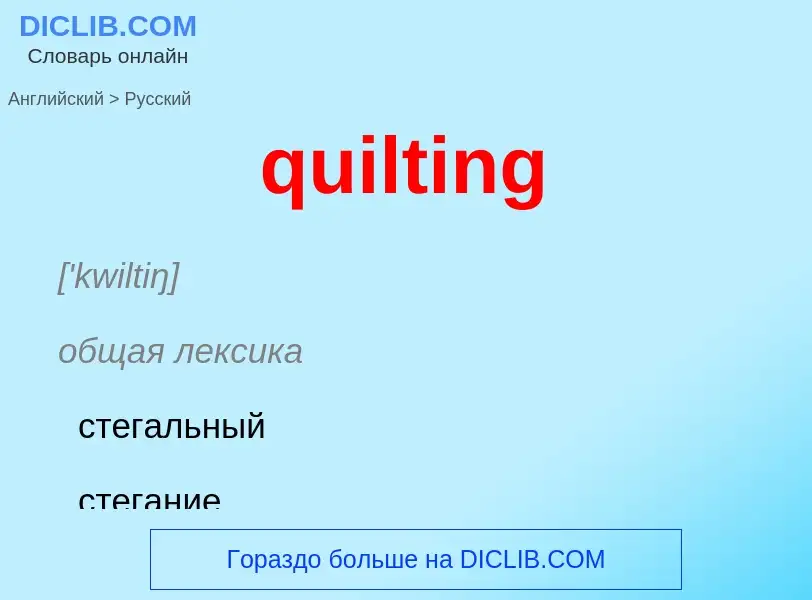Tradução e análise de palavras por inteligência artificial ChatGPT
Nesta página você pode obter uma análise detalhada de uma palavra ou frase, produzida usando a melhor tecnologia de inteligência artificial até o momento:
- como a palavra é usada
- frequência de uso
- é usado com mais frequência na fala oral ou escrita
- opções de tradução de palavras
- exemplos de uso (várias frases com tradução)
- etimologia
quilting - tradução para russo
['kwiltiŋ]
общая лексика
стегальный
стегание
стежка
существительное
общая лексика
стёжка
подбивка
пике (ткани)
крестообразная строчка
['kwiltid]
общая лексика
ватный
стеганый
прилагательное
общая лексика
стёганый
подбитый ватой
ватином и т. п.
['kwiltiŋbi:]
американизм
встреча женщин для (совместного) изготовления стёганых одеял (в деревнях)
Definição
Wikipédia
Quilting is the term given to the process of joining a minimum of three layers of fabric together either through stitching manually using a needle and thread, or mechanically with a sewing machine or specialised longarm quilting system. An array of stitches is passed through all layers of the fabric to create a three dimensional padded surface. The three layers are typically referred to as the top fabric or quilt top, batting or insulating material and the backing.
Quilting varies from a purely functional fabric joinery technique to highly elaborate, decorative three dimensional surface treatments. A wide variety of textile products are traditionally associated with quilting that includes bed coverings, soft home furnishings, garments and costumes, wall hangings, artistic objects and cultural artifacts.
A wide range of effects can be employed by the quilter that contribute to the final surface quality and utility of the quilted material. The quilter controls these effects through the manipulation of elements such as material type and thickness, stitch length and style, pattern design, piecing and cutting. Two dimensional effects such as optical illusions can be achieved through aesthetic choices regarding colour, texture and print. Three dimensional and sculptural components of quilted material can be manipulated and enhanced with further embellishment which may include appliqué, embroidery techniques such as shisha mirror work, and the inclusion of other objects or elements such as pearls, beads, buttons, sequins. Some quilters dye or create their own fabrics. In contemporary artistic quilting, new and experimental materials such as plastics, paper, naturally occurring fibres and plants amongst a diverse array of other materials have been used.
Quilting can be considered one of the first examples of upcycling, as it has historically made extensive use of remnants and offcuts for the creation of new products.


![boro]] shikimono}}), late 1800s Japan. The stitches are decorative, but also functional; they hold the pieced cotton rags together boro]] shikimono}}), late 1800s Japan. The stitches are decorative, but also functional; they hold the pieced cotton rags together](https://commons.wikimedia.org/wiki/Special:FilePath/Child's Sleeping Mat (boro Shikimono), late 19th century (CH 1108827543).jpg?width=200)

![Women of [[Gee's Bend, Alabama]] quilting, 2005 Women of [[Gee's Bend, Alabama]] quilting, 2005](https://commons.wikimedia.org/wiki/Special:FilePath/Gee's Bend quilting bee.jpg?width=200)

 LACMA AC1994.131.1.jpg?width=200)


![Star of Bethlehem Quilt, 1940 from the [[Brooklyn Museum]] Star of Bethlehem Quilt, 1940 from the [[Brooklyn Museum]]](https://commons.wikimedia.org/wiki/Special:FilePath/Star of Bethlehem Quilt.jpg?width=200)

.jpg?width=200)

